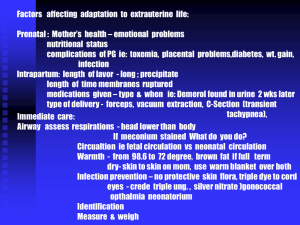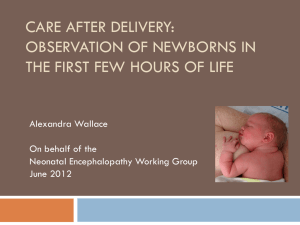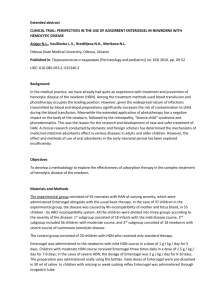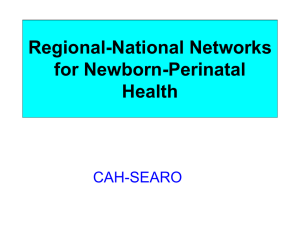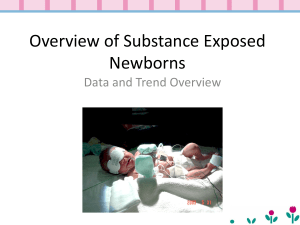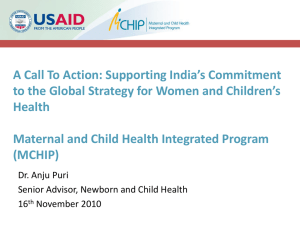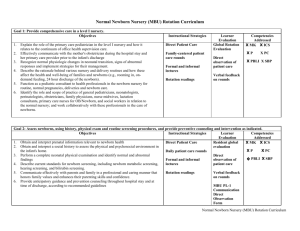Skin, Hair, and Nails
advertisement
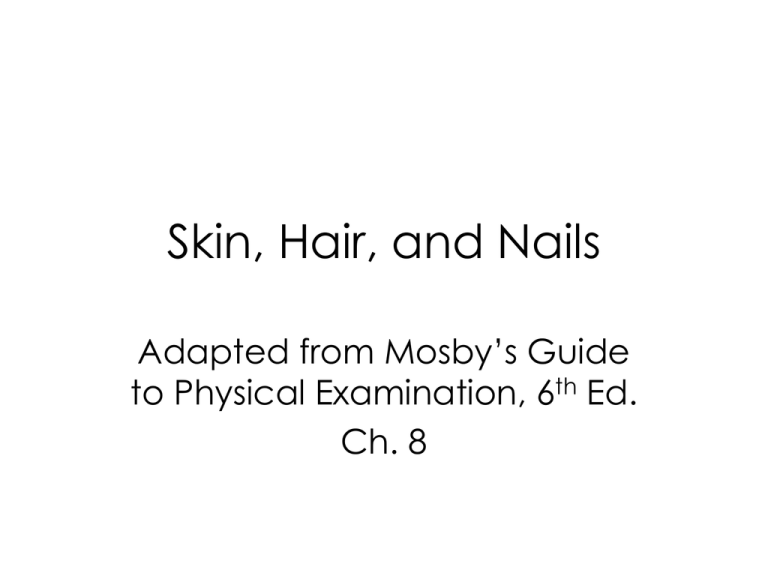
Skin, Hair, and Nails Adapted from Mosby’s Guide to Physical Examination, 6th Ed. Ch. 8 Newborn • Vernix caseosa – Mixture of sebum and cornified epidermis covers the infant’s body at birth – Whitish, moist, cheeselike substance – Protective www.brooksidepress.org/Products/OBGYN_101/MyDocuments4/Text/Newborn/Vernix.jpg Newborn • Transient puffiness of the hands, feet, eyelids, legs, pubis or sacrum occurs in some newborns • Not a concern if it disappears within 2-3 days Newborn • Lanugo – Fine, silky hair covering the newborn • particularly shoulders and back – Shed within 10-14 days Lanugo. This fine body hair resembling peach fuzz is present on infants of 24 to 32 weeks' gestation. Newborn • Some newborns are bald while others are born with an inordinate amount of head hair… – Shed within 2-3 months and replaced by more permanent hair (new texture and color) Newborn • Dark-skinned newborns do not always manifest the intensity of melanosis that will be readily evident in 2-3 months – Exceptions: nail beds and skin of the scrotum Newborn • Skin may look very red the first few days of life – Skin color is partly determined by subcutaneous fat (the less fat, the redder and more transparent the skin) Newborn • Subcutaneous fat – Poorly developed in newborns – Predisposed to hypothermia *Newborns lose heat 4x faster than an adult Expected Color Changes Newborn • Acrocyanosis – Cyanosis of hands & feet • Cutis marmorata – Transient mottling when infant is exposed to decreased temperature CLINICAL NOTE An underlying cardiac defect should be suspected if acrocyanosis is: – persistent – more intense in the feet than hands Expected Color Changes Newborn • Harlequin color change – Clearly outlined color changes as infant lies on side – Lower half of body becomes pink and upper half is pale www.adhb.govt.nz/newborn/TeachingResources/Dermatology/HarlequinColour/Harlequin.jpg Expected Color Changes Newborn • Mongolian spots – Irregular areas of deep blue pigmentation – Usually in sacral and gluteal regions *Seen predominantly in African, Native American, Asian or Latin descent Expected Color Changes Newborn • Telangiectatic nevi (“stork bites”) – Flat, deep pink, localized areas usually seen in back of neck Stork bite, or salmon patch. A typical light red splotchy area is seen at the nape of the neck. Expected Color Changes Newborn • Erythema toxicum – Pink papular rash with vesicles superimposed – Thorax, back, buttocks, and abdomen – May appear 24-48 hrs after birth and resolves after several days Examining the Newborn for Hyperbilirubinemia • Look at the whole body – Starts on the face and descends • Bilirubin level is not high if only the face • May be at a worrisome level if jaundice descends below the nipples • Examine the oral mucosa and sclera • Natural daylight is preferred Physiologic Jaundice • Present in 50% of newborns – Starts after the first day of life – Usually disappears in 8-10 days but may persist for 3-4 weeks Physiologic Jaundice Hyperbilirubinemia in the Newborn Risk Factors: – Breast feeding • b-glucuronidase in breast milk – Cephalhematoma • or other cutaneous or subsutaneous bleeds – Hemolytic disease – Infection Physiological Jaundice • appears to be an inability of the liver to conjugate the bilirubin present in the blood • 5mg/dl bilirubin is visible in the skin • seldom rises above the 20mg/dl necessitating transfusion Physiological Jaundice Treatment • “Bili lamp” & “Bili Blanket” (blue lights), or direct sunlight – helps to conjugate the bilirubin – allows it to clear faster NOTE Intense and persistent jaundice… should consider pathological jaundice – liver disease OR – severe, overwhelming infection Other Causes of Pathological Jaundice • • • • RBC abnormalities & sensitivity Hemorrhage Impaired hepatic function Infections – – – – Toxoplasmosis Rubella Herpes Syphilis Exam • Careful inspection of all skin – Develop a pattern; Don’t overlook body parts • Examine skin creases – Assymetrical creases on thighs • Possible hip dysplasia – Simian Line (hands & feet) • possible Down syndrome Schamroth Technique • Place nail surfaces of corresponding fingers together A. Normal: diamond shaped window B. Clubbed: angle between distal tips increases Clubbing of the Nails • Associated with: – – – – – Respiratory disease Cardiovascular disease Thyroid disease Cirrhosis Colitis Assessing Skin Turgor • Best evaluated by gently pinching a fold of the abdominal skin • Indication of state of hydration and nutrition • Skin that retains “tenting” after it’s pinched indicates: – Dehydration – Malnutrition Normal range is broad. Consider other factors… External Clues to internal Problems External Clues to Internal Problems • Faun tail nevus – Tuft of hair overlying the spinal column usually in the lumbosacral area – Associated with spina bifida occulta External Clues to Internal Problems • Café au lait spots – Evenly pigmented (>5 mm diameter) – Light, dark brown, or black in dark skin – Present at birth or shortly thereafter Café au lait spots may be related to: – – – – Neurofibromatosis Pulmonary stenosis Temporal lobe dysrhythmia Tuberous sclerosis Suspect neurofibromatosis if you note: >5 patches with diameters >1cm in a child under 5 External Clues to Internal Problems • Freckling in the axillary or inguinal area – May occur in conjunction with café au lait spots – Associated with neurofibromatosis External Clues to Internal Problems • Facial port-wine stain When it involves the opthalmic division of the trigeminal nerve it may be associated with: • Sturge-Weber syndrome – seizures • Occular defects External Clues to Internal Problems • Supernumerary nipples – Especially in the presence of other minor abnormalities… •associated with renal abnormalities Common Conditions • Milia – Small white discrete papules on the face (bridge of the nose) – Plugged sebaceous glands – Common during the first 2-3 months Allergic reaction Heat rash (miliaria) • Miliaria aka “Prickly Heat” (crystaline) – Caused by occlusion of sweat ducts during periods of heat and high humidity • Diaper rash – Over the buttocks and anogenitals • acid urine output • yeast • Eczematous rash Typical sites of eczema Younger children • Face, elbow, knees Older children & adults • Hands, neck, inner elbows, back of knees, ankles • Face (less often) • Ring worm – Tinea corporis – Tinea capitis Most common vector? • Seborrheic Dermatitis – Chronic, recurrent erythematous scaling eruption – Areas dense with sebaceous glands • Scalp, back, intertriginous, & diaper areas “Cradle Cap” – Scalp Lesions are scaling, adherent, thick, yellow, and crusted – Can spread over the ear and down the nape of the neck • Impetigo – Highly contagious Staph. or Strep. infection – Honey colored crusts – Causes pruritis, burning, and regional lymphadenpathy • Strawberry hemangioma Birth: often not present or noticeable 1-2 months: becomes noticeable 1-6 months: grows most rapidly 12-18 months: begins to shrink • Trichotillomania – Excessive emotional stress – Obsessive Compulsive Disorder

